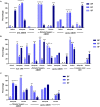Association study between hypothalamic functional connectivity, early nutrition, and glucose levels in healthy children aged 6 years: The COGNIS study follow-up
- PMID: 36313089
- PMCID: PMC9597646
- DOI: 10.3389/fnut.2022.935740
Association study between hypothalamic functional connectivity, early nutrition, and glucose levels in healthy children aged 6 years: The COGNIS study follow-up
Abstract
Breastfeeding (BF) is the gold standard in infant nutrition; knowing how it influences brain connectivity would help understand the mechanisms involved, which would help close the nutritional gap between infant formulas and breast milk. We analyzed potential long-term differences depending on the diet with an experimental infant formula (EF), compared to a standard infant formula (SF) or breastfeeding (BF) during the first 18 months of life on children's hypothalamic functional connectivity (FC) assessed at 6 years old. A total of 62 children participating in the COGNIS randomized clinical trial (Clinical Trial Registration: www.ClinicalTrials.gov, identifier: NCT02094547) were included in this study. They were randomized to receive an SF (n = 22) or a bioactive nutrient-enriched EF (n = 20). BF children were also included as a control study group (BF: n = 20). Brain function was evaluated using functional magnetic resonance imaging (fMRI) and mean glucose levels were collected through a 24-h continuous glucose monitoring (CGM) device at 6 years old. Furthermore, nutrient intake was also analyzed during the first 18 months of life and at 6 years old through 3-day dietary intake records. Groups fed with EF and BF showed lower FC between the medial hypothalamus (MH) and the anterior cingulate cortex (ACC) in comparison with SF-fed children. Moreover, the BF children group showed lower FC between the MH and the left putamen extending to the middle insula, and higher FC between the MH and the inferior frontal gyrus (IFG) compared to the EF-fed children group. These areas are key regions within the salience network, which is involved in processing salience stimuli, eating motivation, and hedonic-driven desire to consume food. Indeed, current higher connectivity found on the MH-IFG network in the BF group was associated with lower simple sugars acceptable macronutrient distribution ranges (AMDRs) at 6 months of age. Regarding linoleic acid intake at 12 months old, a negative association with this network (MH-IFG) only in the BF group was found. In addition, BF children showed lower mean glucose levels compared to SF-fed children at 6 years old. Our results may point out a possible relationship between diet during the first 18 months of life and inclined proclivity for hedonic eating later in life.
Clinical trial registration: https://www.clinicaltrials.gov/, identifier NCT02094547.
Keywords: eating behavior; hypothalamus; long chain polyunsaturated fatty acids (LC-PUFAs); mean glucose levels; milk fat globule membrane (MFGM); neuroimaging; synbiotics.
Copyright © 2022 Diéguez, Nieto-Ruiz, Martín-Pérez, Sepúlveda-Valbuena, Herrmann, Jiménez, De-Castellar, Catena, García-Santos, Bermúdez and Campoy.
Conflict of interest statement
Authors JJ and RD-C are employees of Ordesa Laboratories, S.L. The remaining authors declare that the research was conducted in the absence of any commercial or financial relationships that could be construed as a potential conflict of interest.
Figures




Similar articles
-
Long-Term Effects and Potential Impact of Early Nutrition with Breast Milk or Infant Formula on Glucose Homeostasis Control in Healthy Children at 6 Years Old: A Follow-Up from the COGNIS Study.Nutrients. 2023 Feb 7;15(4):852. doi: 10.3390/nu15040852. Nutrients. 2023. PMID: 36839210 Free PMC article.
-
Infant Formula Supplemented With Milk Fat Globule Membrane, Long-Chain Polyunsaturated Fatty Acids, and Synbiotics Is Associated With Neurocognitive Function and Brain Structure of Healthy Children Aged 6 Years: The COGNIS Study.Front Nutr. 2022 Mar 9;9:820224. doi: 10.3389/fnut.2022.820224. eCollection 2022. Front Nutr. 2022. PMID: 35356726 Free PMC article.
-
The Effects of an Infant Formula Enriched with Milk Fat Globule Membrane, Long-Chain Polyunsaturated Fatty Acids and Synbiotics on Child Behavior up to 2.5 Years Old: The COGNIS Study.Nutrients. 2020 Dec 15;12(12):3825. doi: 10.3390/nu12123825. Nutrients. 2020. PMID: 33333767 Free PMC article. Clinical Trial.
-
The role of polyunsaturated fatty acids in term and preterm infants and breastfeeding mothers.Pediatr Clin North Am. 2001 Feb;48(1):173-88. doi: 10.1016/s0031-3955(05)70292-3. Pediatr Clin North Am. 2001. PMID: 11236724 Review.
-
[Simple obesity in children. A study on the role of nutritional factors].Med Wieku Rozwoj. 2006 Jan-Mar;10(1):3-191. Med Wieku Rozwoj. 2006. PMID: 16733288 Review. Polish.
Cited by
-
Near-Infrared Spectroscopy: A Free-Living Neuroscience Tool to Better Understand Diabetes and Obesity.Metabolites. 2023 Jul 3;13(7):814. doi: 10.3390/metabo13070814. Metabolites. 2023. PMID: 37512521 Free PMC article. Review.
-
MRI-Based Structural Development of the Human Newborn Hypothalamus.bioRxiv [Preprint]. 2025 Jun 21:2025.06.20.660741. doi: 10.1101/2025.06.20.660741. bioRxiv. 2025. PMID: 40667207 Free PMC article. Preprint.
-
Long-Term Effects and Potential Impact of Early Nutrition with Breast Milk or Infant Formula on Glucose Homeostasis Control in Healthy Children at 6 Years Old: A Follow-Up from the COGNIS Study.Nutrients. 2023 Feb 7;15(4):852. doi: 10.3390/nu15040852. Nutrients. 2023. PMID: 36839210 Free PMC article.
-
Higher in-hospital proportion of breast milk intake improves brain functional connectivity and neurological assessment in preterm infants.Front Pediatr. 2025 Apr 16;13:1508840. doi: 10.3389/fped.2025.1508840. eCollection 2025. Front Pediatr. 2025. PMID: 40309165 Free PMC article.
References
Associated data
LinkOut - more resources
Full Text Sources
Medical
Miscellaneous

